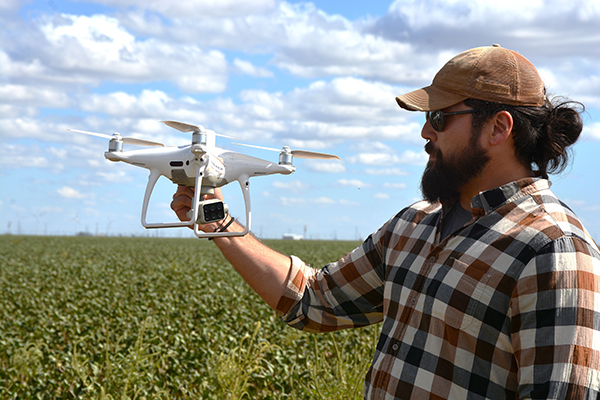Emerging soil scientist cultivates future in cotton sustainability – AgriLife Today

Research Initiative on Sustainable Agriculture and Water Conservation in Semi-Arid Cotton Production
Introduction
A doctoral research project at Texas A&M University, led by Chris Cobos of the College of Agriculture and Life Sciences, is addressing critical challenges in agricultural sustainability. The research focuses on enhancing the resiliency of cotton cropping systems in the semi-arid South Plains of Texas, with a direct impact on several United Nations Sustainable Development Goals (SDGs).
Core Objectives and Alignment with Sustainable Development Goals (SDGs)
The primary goal is to optimize soil water conservation and improve soil health through regenerative agricultural practices. This initiative directly supports the following SDGs:
- SDG 6 (Clean Water and Sanitation): By developing methods for efficient water use in dryland and deficit-irrigated systems, the research aims to ensure sustainable water management for agriculture.
- SDG 2 (Zero Hunger): The project promotes resilient agricultural practices that increase productivity and maintain yields in water-scarce environments, contributing to food and fiber security.
- SDG 13 (Climate Action): Regenerative systems, including the use of cover crops, enhance soil health and build resilience to climate-related challenges such as drought.
- SDG 15 (Life on Land): The focus on soil water dynamics and conservation practices contributes to combating desertification and halting land degradation.
Methodology and Technological Innovation
Research Focus Areas
The research investigates the efficacy of specific conservation practices to improve agricultural viability. Key areas of study include:
- Soil Water Dynamics: Analyzing water availability over time in systems utilizing cover crops and crop rotations (e.g., cotton-wheat-fallow).
- Regenerative Systems Viability: Evaluating the performance of these systems under true dryland conditions to ensure long-term profitability and productivity without supplemental irrigation.
- Adaptation Strategies: Identifying sustainable management practices that allow farmers to adapt to increasingly arid conditions while maintaining cotton production.
Integration of Advanced Technology for SDG 9
In alignment with SDG 9 (Industry, Innovation, and Infrastructure), the project leverages cutting-edge technology to create practical solutions for producers.
- Drone and AI Application: In collaboration with Dr. Gurjinder Baath, drones and artificial intelligence are used to gather data on cover crop growth and biomass.
- Decision Support Tool: The data collected is being used to develop a tool that helps producers determine the optimal timing for cover crop termination. This tool analyzes plant, soil, and meteorological data to forecast impacts on cotton lint yield, thereby maximizing resource efficiency.
Implications for Sustainable Production and Livelihoods
Enhancing Agricultural Resilience
The research findings are intended to provide actionable strategies for farmers in the Southern High Plains. By implementing regenerative systems, producers can achieve greater resiliency against water scarcity, leading to more stable yields and enhanced profitability. This directly supports SDG 12 (Responsible Consumption and Production) by fostering sustainable agricultural production patterns.
Commitment to Producer Livelihoods
The project is driven by a commitment to addressing the real-world challenges faced by agricultural producers. The ultimate aim is to develop and disseminate conservation management practices that ensure the long-term economic and environmental sustainability of farming in the region, thereby securing livelihoods for future generations.
Analysis of Sustainable Development Goals in the Article
1. Which SDGs are addressed or connected to the issues highlighted in the article?
- SDG 2: Zero Hunger: The article’s focus on sustainable agriculture, soil health, and the resiliency of cropping systems directly relates to ensuring sustainable food (and fiber) production.
- SDG 6: Clean Water and Sanitation: The core of the research is water conservation in agriculture. The article repeatedly mentions the need to “conserve water,” manage “limited water resources,” and optimize “soil water conservation” in semi-arid regions.
- SDG 9: Industry, Innovation, and Infrastructure: The research heavily relies on modern technology and scientific innovation. The use of “drones and artificial intelligence to gather data” and the development of a “decision support tool” for farmers highlight the role of technology in advancing sustainable agriculture.
- SDG 12: Responsible Consumption and Production: The research promotes sustainable production patterns in agriculture by focusing on “regenerative systems” and the efficient use of natural resources, specifically water, to produce cotton.
- SDG 13: Climate Action: The article addresses the need for agriculture to adapt to climate change. The research aims to improve the “resiliency” of cropping systems to cope with “increasingly limited water resources” and “an increasingly drier or arid environment,” which are consequences of climate change.
2. What specific targets under those SDGs can be identified based on the article’s content?
- Target 2.4: “By 2030, ensure sustainable food production systems and implement resilient agricultural practices that increase productivity and production…” The research on “regenerative cotton cropping systems,” “cover crops,” and “rotations such as cotton-wheat-fallow” is a direct effort to implement resilient practices that improve sustainability and yield.
- Target 6.4: “By 2030, substantially increase water-use efficiency across all sectors and ensure sustainable withdrawals…” The primary goal of the research is to “help farmers conserve water” and “optimize soil water conservation” in “dryland and deficit-irrigated systems,” which directly contributes to increasing water-use efficiency in agriculture.
- Target 9.5: “Enhance scientific research, upgrade the technological capabilities of industrial sectors in all countries…encouraging innovation…” The project’s use of “drones and AI to develop a decision support tool for producers” is a clear example of enhancing scientific research and upgrading technological capabilities within the agricultural sector.
- Target 12.2: “By 2030, achieve the sustainable management and efficient use of natural resources.” The research focuses on the efficient use of water and the improvement of soil health, which are critical natural resources for cotton production.
- Target 13.1: “Strengthen resilience and adaptive capacity to climate-related hazards and natural disasters in all countries.” The research aims to make cropping systems more resilient and help farmers “adapt to drier conditions,” thereby strengthening the agricultural sector’s capacity to cope with climate-related hazards like drought.
3. Are there any indicators mentioned or implied in the article that can be used to measure progress towards the identified targets?
- Yield and Profitability of Regenerative Systems: The article implies these are key metrics by stating that conservation practices allow systems to “yield more and be more profitable than conventional systems.” This can measure progress towards Target 2.4.
- Soil Water Availability: The research specifically studies “soil water dynamics” and “water availability over time.” These measurements serve as direct indicators of improved water conservation and efficiency, relevant to Targets 6.4 and 12.2.
- Development of a Decision Support Tool: The creation and adoption of the AI-powered tool to “forecast optimal cover crop termination timing” is a tangible indicator of technological innovation and application in agriculture, measuring progress for Target 9.5.
- Productivity in Dryland Conditions: A key challenge mentioned is to “ensure these systems remain productive without supplemental water.” The ability to maintain cotton production levels in an “increasingly drier or arid environment” would be a direct indicator of resilience and adaptive capacity, relevant to Target 13.1.
- Cotton Lint Yield: The decision support tool analyzes various data points to determine “which factors most influence cotton lint yield.” This yield is a primary indicator of the success of the implemented sustainable practices.
4. Summary Table of SDGs, Targets, and Indicators
| SDGs | Targets | Indicators |
|---|---|---|
| SDG 2: Zero Hunger | 2.4: Ensure sustainable food production systems and implement resilient agricultural practices. | Yield and profitability of regenerative systems compared to conventional ones. |
| SDG 6: Clean Water and Sanitation | 6.4: Substantially increase water-use efficiency across all sectors. | Measurements of soil water dynamics and water availability over time in cropping systems. |
| SDG 9: Industry, Innovation, and Infrastructure | 9.5: Enhance scientific research and upgrade technological capabilities. | Development and application of the drone and AI-based decision support tool for farmers. |
| SDG 12: Responsible Consumption and Production | 12.2: Achieve the sustainable management and efficient use of natural resources. | Optimized water use in deficit-irrigated systems and improved soil health metrics. |
| SDG 13: Climate Action | 13.1: Strengthen resilience and adaptive capacity to climate-related hazards. | Sustained productivity and yield of cotton in true dryland or increasingly arid conditions. |
Source: agrilifetoday.tamu.edu
What is Your Reaction?
 Like
0
Like
0
 Dislike
0
Dislike
0
 Love
0
Love
0
 Funny
0
Funny
0
 Angry
0
Angry
0
 Sad
0
Sad
0
 Wow
0
Wow
0
















































/environment-climate-change-and-health-(ech)/water-sanitation-hygiene-and-health-(wsh)/landfill-tuvalu-36092.tmb-1200v.jpg?sfvrsn=5c21fe40_1#)

.jpg.webp?itok=0ZsAnae9#)

























